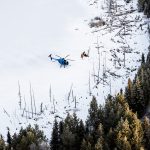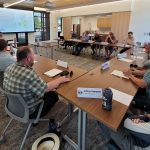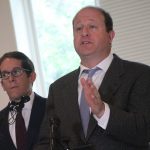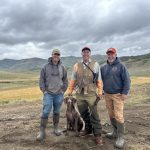Landscape recovery after Rio Blanco County fires could take 1-5 years

Elk and Lee Fire InciWeb/Courtesy photo
Long-term recovery of the landscape from the large footprint of damage caused by two wildfires in Rio Blanco County may require one to five years of repair efforts from nature, landowners and multiple agencies, according to a lead resource advisor.
Water, soil erosion and land health are the top post-fire priorities currently determined by the on-site resource advisor team members, said Wendy Parker, team lead and U.S. Bureau of Land Management fire and fuels archaeologist.
The factors of water, soil erosion and land health “can have effects to life, property, the environment and economic drivers such as ranching and livestock and oil and gas industry as buried lines and facilities may be impacted by such natural forces,” Parker said.
Resource advisors from the BLM and other agencies helped throughout the wildfires near Meeker to provide advice on sensitive and critical resource values at risk that were most susceptible to impacts of suppression activities, Parker said.
Additionally, a Burned Area Emergency Resource team, or BAER, is mobilizing to Meeker to provide additional assistance and damage assessment as a second set of eyes to help the exhausted local resource advisors, Parker said.
The experienced, interagency BAER team is expected to release a final report in three weeks to provide further direction in local staff and teams for restoration steps to bring the landscape back to a healthy ecosystem. BAER teams commonly include a hydrologist, biologist, ecologist, archeologist, GIS mapping specialist and others.
Work is well underway for immediate stabilization and repair of fire suppression impacts such as damage from bulldozers that created firebreaks, pushed up berms, widened roads, scraped off dry vegetation or pushed down fences. Other necessary restoration work can include repairing culverts, chipping slash piles, installing water bars, placing wattles or downing damaged trees for erosion control, and reseeding with native, fast-growing grasses such as Indian ricegrass to keep invasive weeds from taking over the landscape.
Parker said recovery recommendations also cover properties immediately adjacent to the fire parameters “to best protect life, property and environmental concerns.”
“The cumulative effects, soil erosion and sediment flow can impact properties downstream from where fire occurred,” Parker noted.

The BLM specialist said during her own travels in the wildfire damaged area she identified six small groups of escaped cattle and found a llama more than 3 miles from home trying to find its way back.
After a large wildfire, damage to water could range from negative impacts to livestock reservoirs to run-off depositing silt and debris in streams or, in some cases, water diverting from natural channels, Parker noted. Soil erosion and mudslides have already been reported, including a mudslide closure of Rio Blanco County Road 5 on Aug. 27.
The timeline for grazing-permit lands to recover to a healthy state depends on the specific environment and burn severity, Parker said, noting “if it is severely burned, it will take a while for nutrients to come back into the soils.” Prairie sagebrush and grassy areas may recover in about a year, she said.
Parker said structure protection crews did a “fantastic job” during the wildfires.
“The structure team did an incredible job of saving homes and property,” Parker noted. “There were several instances where burnt fuels were all around several people’s properties. The structure team kept the fire at their fence lines and managed to save many structures.”
She highlighted a specific protection success story in her area of expertise as an archaeologist. She informed firefighters about the historic Elk Creek Schoolhouse along Rio Blanco County Road 8 in the Elk Fire east of Meeker, and fire crews were able to stop the wildfire at the fence line of the rural school built in 1921.
Another success story came with the combined efforts of ranchers, community members and resource advisors working to get animals out of harm’s way that kept livestock deaths to a minimum, officials said.
“One of the key roles the READs, (Resource Advisors), played during that effort was identifying permittees who graze livestock on public lands, gathering contact information for the Incident Management Team’s liaison and notifying those permittees to let them know that their property/livestock were at risk and how best to facilitate moving those animals such as getting a pass that would allow those folks to enter closure areas to remove the animals,” Parker explained.
Parker said additional issues related to the wildfire damage in Rio Blanco County and included: range concerns for livestock grazing and ranching; possible impacts to oil and gas industry operations; ecological concerns including wildlife, vegetation and fish ecosystems; public land use for hunting and recreation; and cultural resources such as historic places.
As of 6 a.m. Monday, the FDNY Incident Management Team turned the wildfire management over to local agencies as containment of the 137,758-acre Lee Fire increased to 99%, according to Incident Commander Kyle Demasters.
“While this marks tremendous progress, there is still work to be done,” Demasters said. “Local agencies will take command of the incident and will continue managing a smaller group of resources to carry out repair work.”
For future questions, Demasters instructed residents to contact the Rio Blanco County Sheriff’s Office or the Bureau of Land Management.
CSU Extension’s “After the Disaster Guidebook” also includes substantial advice and county-specific resource information online at https://rbc.us/DocumentCenter/View/6079/After-the-Disaster-Guidebook_Extension-Rio-BlancoTemplate.
Rio Blanco County Public Information Coordinator Lynn Lockwood explained that during the past few weeks, the county convened community partners to form “Rio Blanco Recovery,” an umbrella team for multiple lanes of recovery efforts. The county plans to hire a recovery manager to serve as the central point of coordination for Rio Blanco Recovery “to align work areas and support internal and external stakeholders throughout the recovery process,” Lockwood said.
“Following the fires, multiple agencies and organizations will use post-fire risk and damage assessment tools such as BAER (Burned Area Emergency Response) to inform restoration and mitigation strategies on both public and private lands,” Lockwood said.
Lockwood said several sub-groups are focusing on specific aspects of recovery. For example, a Natural Resources and Agriculture group of federal and regional agencies is working on programs to help landowners with fencing, cattle losses, drought, habitat restoration and post-fire water issues.
That group includes such agencies as the Natural Resources Conservation Service, Farm Service Agency, Colorado Parks and Wildlife, U.S. Geological Survey, Rio Blanco Water Conservancy District, towns of Meeker and Rangely, and White River and Douglas Creek conservation districts.
For example, the USGS is mapping debris flow hazards, and conservation district staff are leading outreach and education to help landowners understand options, Lockwood said.
Lockwood said the county is collecting data through a damage and loss questionnaire from agricultural producers, outfitters and rural landowners impacted by the fires.
The combined efforts are important for directing resources and implementing projects that protect property and infrastructure from potential flooding and other post-fire hazards as well as for application for federal funding opportunities such as the NRCS Emergency Watershed Protection program, Lockwood said.
Lockwood said other efforts include an Economic Recovery group as well as county employees in six departments working together with industry and business representatives “to address critical needs.”
People wishing to donate to help impacted residents can donate to the “Lee & Elk Wildfire Recovery Fund” set up through the Yampa Valley Community Foundation online at YVCF.fcsuite.com/erp/donate. So far, the fund has raised some $70,000, according to the foundation.
To reach Suzie Romig, call 970-871-4205 or email sromig@SteamboatPilot.com.

Support Local Journalism

Support Local Journalism
Readers around Steamboat and Routt County make the Steamboat Pilot & Today’s work possible. Your financial contribution supports our efforts to deliver quality, locally relevant journalism.
Now more than ever, your support is critical to help us keep our community informed about the evolving coronavirus pandemic and the impact it is having locally. Every contribution, however large or small, will make a difference.
Each donation will be used exclusively for the development and creation of increased news coverage.










